inflation pressure TOYOTA YARIS HYBRID 2016 Owners Manual
[x] Cancel search | Manufacturer: TOYOTA, Model Year: 2016, Model line: YARIS HYBRID, Model: TOYOTA YARIS HYBRID 2016Pages: 492, PDF Size: 31.95 MB
Page 4 of 492
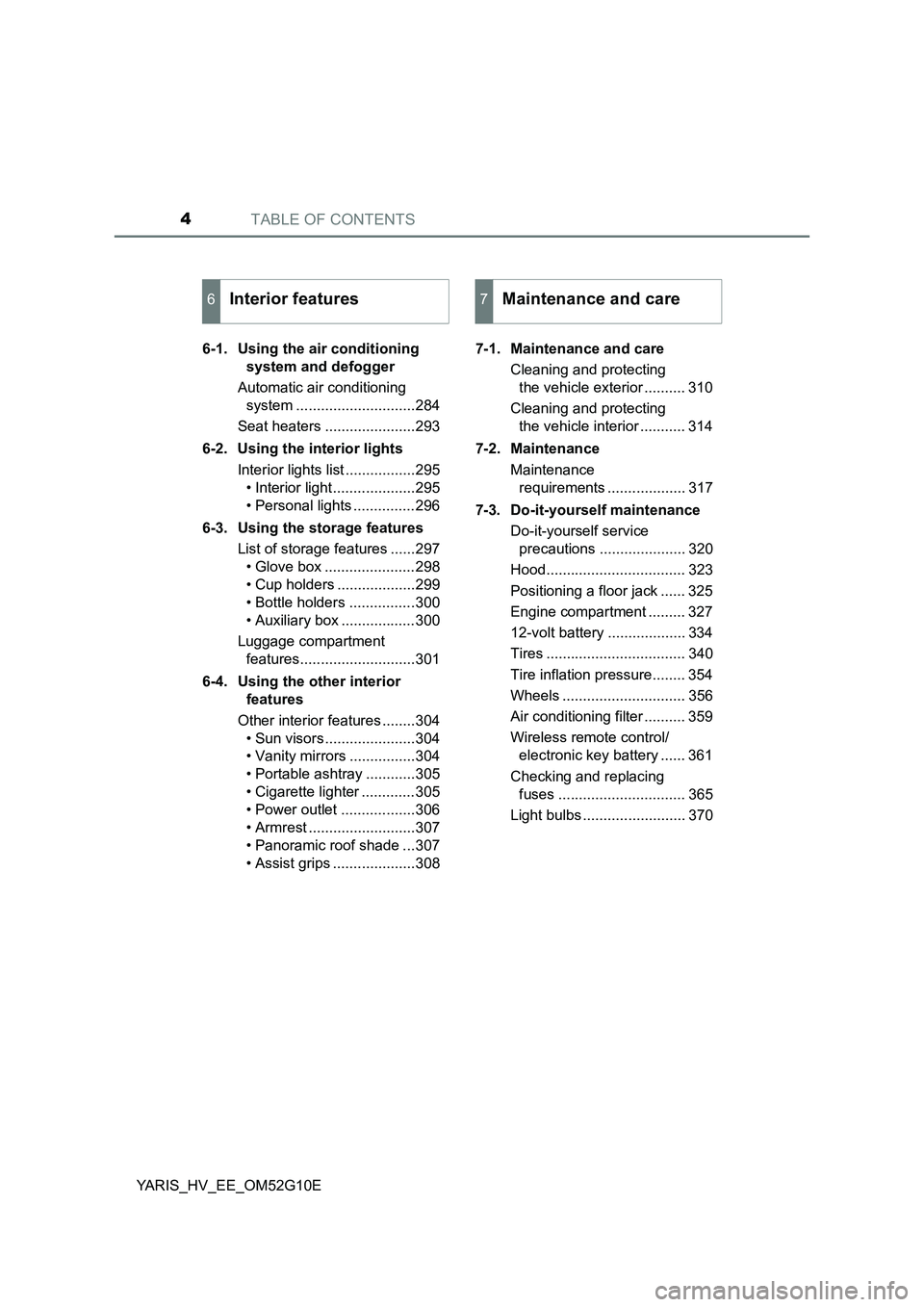
TABLE OF CONTENTS4
YARIS_HV_EE_OM52G10E
6-1. Using the air conditioning
system and defogger
Automatic air conditioning
system .............................284
Seat heaters ......................293
6-2. Using the interior lights
Interior lights list .................295
• Interior light ....................295
• Personal lights ...............296
6-3. Using the storage features
List of storage features ......297
• Glove box ......................298
• Cup holders ...................299
• Bottle holders ................300
• Auxiliary box ..................300
Luggage compartment
features............................301
6-4. Using the other interior
features
Other interior features ........304
• Sun visors ......................304
• Vanity mirrors ................304
• Portable ashtray ............305
• Cigarette lighter .............305
• Power outlet ..................306
• Armrest ..........................307
• Panoramic roof shade ...307
• Assist grips ....................308
7-1. Maintenance and care
Cleaning and protecting
the vehicle exterior .......... 310
Cleaning and protecting
the vehicle interior ........... 314
7-2. Maintenance
Maintenance
requirements ................... 317
7-3. Do-it-yourself maintenance
Do-it-yourself service
precautions ..................... 320
Hood.................................. 323
Positioning a floor jack ...... 325
Engine compartment ......... 327
12-volt battery ................... 334
Tires .................................. 340
Tire inflation pressure........ 354
Wheels .............................. 356
Air conditioning filter .......... 359
Wireless remote control/
electronic key battery ...... 361
Checking and replacing
fuses ............................... 365
Light bulbs ......................... 370
6Interior features7Maintenance and care
Page 13 of 492
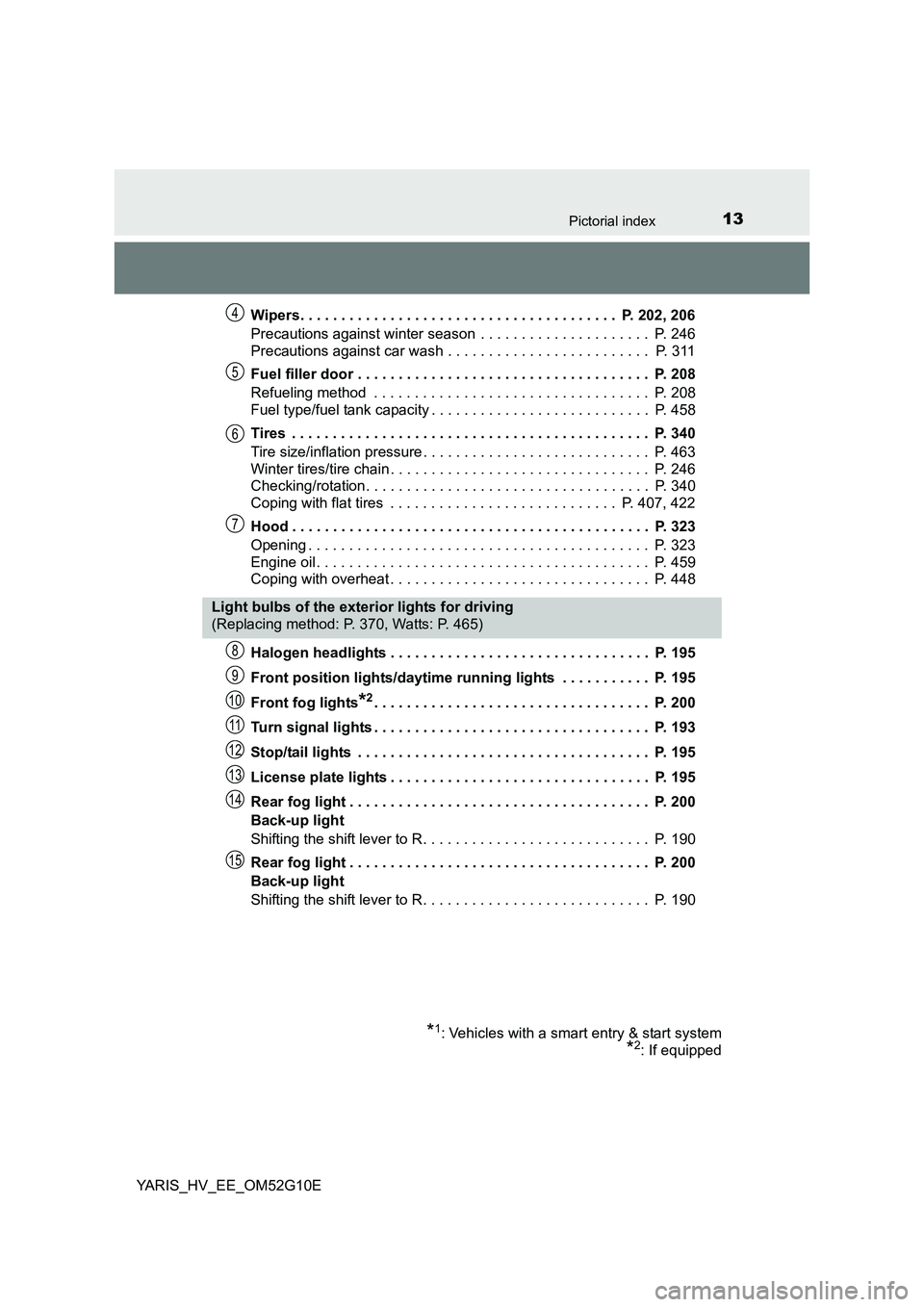
13Pictorial index
YARIS_HV_EE_OM52G10E
Wipers. . . . . . . . . . . . . . . . . . . . . . . . . . . . . . . . . . . . . . . P. 202, 206
Precautions against winter season . . . . . . . . . . . . . . . . . . . . . P. 246
Precautions against car wash . . . . . . . . . . . . . . . . . . . . . . . . . P. 311
Fuel filler door . . . . . . . . . . . . . . . . . . . . . . . . . . . . . . . . . . . . P. 208
Refueling method . . . . . . . . . . . . . . . . . . . . . . . . . . . . . . . . . . P. 208
Fuel type/fuel tank capacity . . . . . . . . . . . . . . . . . . . . . . . . . . . P. 458
Tires . . . . . . . . . . . . . . . . . . . . . . . . . . . . . . . . . . . . . . . . . . . . P. 340
Tire size/inflation pressure . . . . . . . . . . . . . . . . . . . . . . . . . . . . P. 463
Winter tires/tire chain . . . . . . . . . . . . . . . . . . . . . . . . . . . . . . . . P. 246
Checking/rotation. . . . . . . . . . . . . . . . . . . . . . . . . . . . . . . . . . . P. 340
Coping with flat tires . . . . . . . . . . . . . . . . . . . . . . . . . . . . P. 407, 422
Hood . . . . . . . . . . . . . . . . . . . . . . . . . . . . . . . . . . . . . . . . . . . . P. 323
Opening . . . . . . . . . . . . . . . . . . . . . . . . . . . . . . . . . . . . . . . . . . P. 323
Engine oil . . . . . . . . . . . . . . . . . . . . . . . . . . . . . . . . . . . . . . . . . P. 459
Coping with overheat . . . . . . . . . . . . . . . . . . . . . . . . . . . . . . . . P. 448
Halogen headlights . . . . . . . . . . . . . . . . . . . . . . . . . . . . . . . . P. 195
Front position lights/daytime running lights . . . . . . . . . . . P. 195
Front fog lights*2. . . . . . . . . . . . . . . . . . . . . . . . . . . . . . . . . . P. 200
Turn signal lights . . . . . . . . . . . . . . . . . . . . . . . . . . . . . . . . . . P. 193
Stop/tail lights . . . . . . . . . . . . . . . . . . . . . . . . . . . . . . . . . . . . P. 195
License plate lights . . . . . . . . . . . . . . . . . . . . . . . . . . . . . . . . P. 195
Rear fog light . . . . . . . . . . . . . . . . . . . . . . . . . . . . . . . . . . . . . P. 200
Back-up light
Shifting the shift lever to R. . . . . . . . . . . . . . . . . . . . . . . . . . . . P. 190
Rear fog light . . . . . . . . . . . . . . . . . . . . . . . . . . . . . . . . . . . . . P. 200
Back-up light
Shifting the shift lever to R. . . . . . . . . . . . . . . . . . . . . . . . . . . . P. 190
4
5
6
7
Light bulbs of the exterior lights for driving
(Replacing method: P. 370, Watts: P. 465)
*1: Vehicles with a smart entry & start system
*2: If equipped
8
9
10
11
12
13
14
15
Page 226 of 492

2264-5. Toyota Safety Sense
YARIS_HV_EE_OM52G10E
■Temporary cancelation of the LDA system functions
If any of the following occurs, the LDA system functions will be temporarily
canceled. The functions will resume after the necessary operating conditions
have returned.
● The turn signal lever is operated.
● The vehicle speed deviates from the operating range of the LDA system
functions.
● When the lane lines cannot be recognized while driving.
● When the lane departure warning sounds.
The lane departure warning function will not operate again for a several sec-
onds after it has been activated, even if the vehicle leaves the lane again.
■ The lane departure warning
Depending on the audio system sound level or air conditioning fan noise
while the audio system or air conditioning sy stem is in use, it may be difficult
to hear the warning sound.
■ After the vehicle has been parked in the sun
The LDA system may not be immediatel y available. When the temperature in
the cabin decreases and the temperature around the front sensor ( P. 212)
becomes suitable for its operation, the functions will begin to operate.
■ If there are lane markers on only one side of the vehicle
The lane departure warning will not operate for the side on which lane mark-
ers could not be recognized.
■ Conditions in which the function may not operate correctly
In the following situations, the front sensor may be unable to recognize lane
markers causing the lane departure warning function to operate incorrectly.
However, this does not indicate a malfunction.
● When driving through an area, such as a tollbooth, a crossing or before a
ticket checkpoint
● When driving on a sharp curve
● When lane markers are extremely narrow or extremely wide
● When the vehicle leans to one side an unusual amount due to a heavy load
or improper tire inflation pressure
● When the following distance between your vehicle and the vehicle ahead is
extremely short
● When the lane markers are yellow (These may be more difficult for the sys-
tem to recognize compared to white markers.)
● When the lane markers are broken, Botts’ dots (raised pavement markers)
or stones
Page 242 of 492
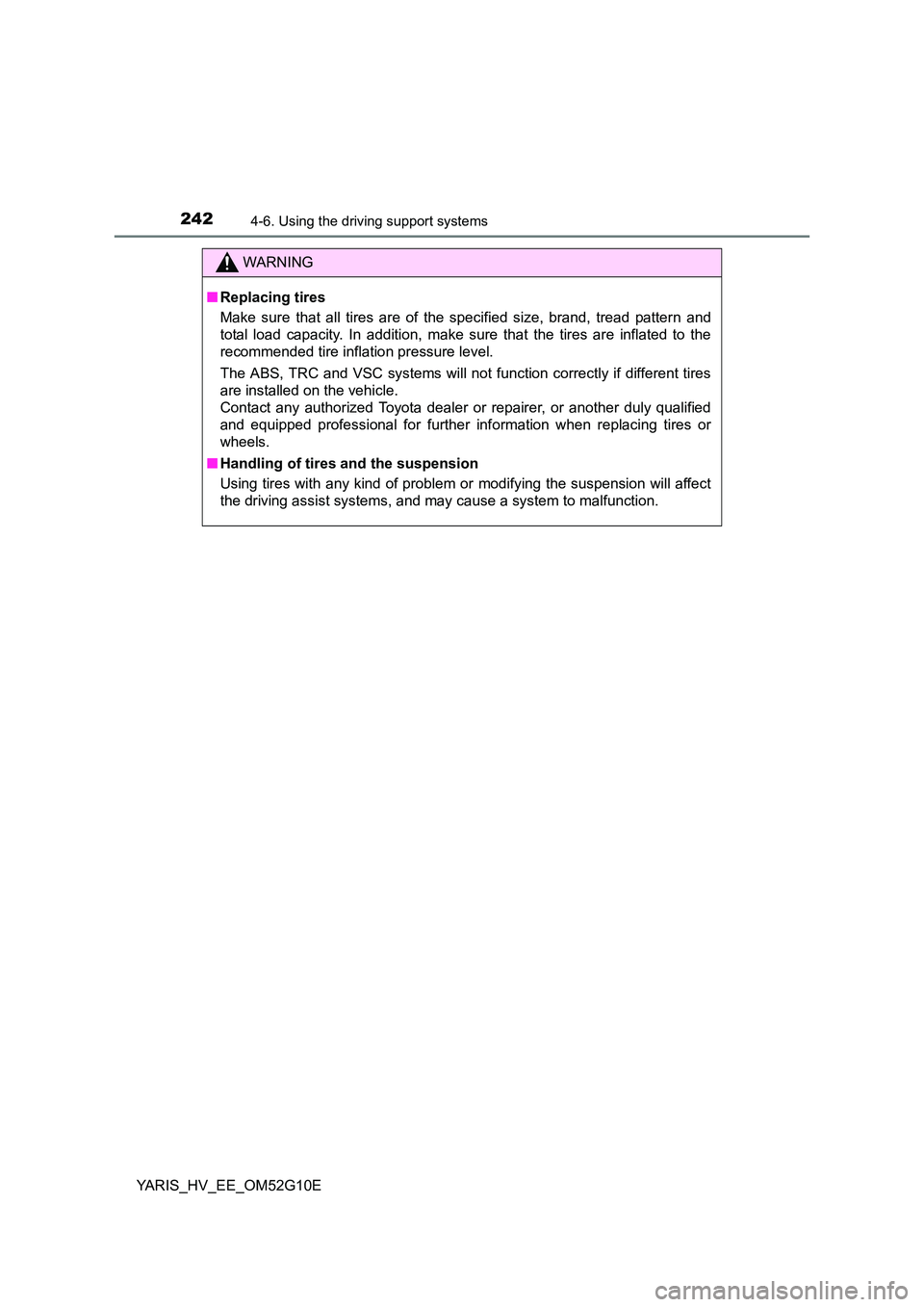
2424-6. Using the driving support systems
YARIS_HV_EE_OM52G10E
WARNING
■Replacing tires
Make sure that all tires are of the specified size, brand, tread pattern and
total load capacity. In addition, make sure that the tires are inflated to the
recommended tire inflation pressure level.
The ABS, TRC and VSC systems will not function correctly if different tires
are installed on the vehicle.
Contact any authorized Toyota dealer or repairer, or another duly qualified
and equipped professional for further in formation when replacing tires or
wheels.
■ Handling of tires and the suspension
Using tires with any kind of problem or modifying the suspension will affect
the driving assist systems, and may cause a system to malfunction.
Page 245 of 492
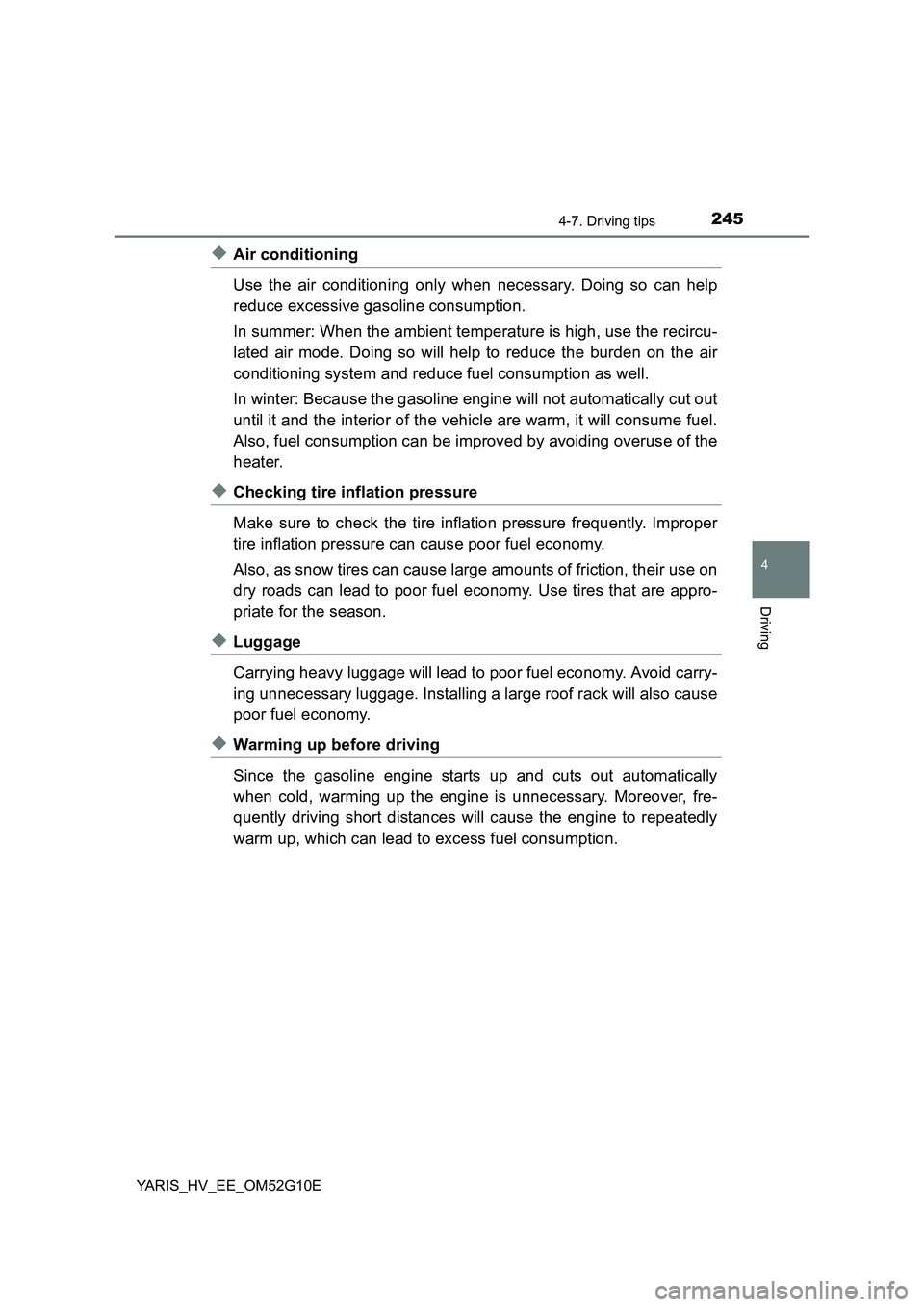
2454-7. Driving tips
4
Driving
YARIS_HV_EE_OM52G10E
◆Air conditioning
Use the air conditioning only when necessary. Doing so can help
reduce excessive gasoline consumption.
In summer: When the ambient temperature is high, use the recircu-
lated air mode. Doing so will help to reduce the burden on the air
conditioning system and reduce fuel consumption as well.
In winter: Because the gasoline engine will not automatically cut out
until it and the interior of the vehicle are warm, it will consume fuel.
Also, fuel consumption can be improved by avoiding overuse of the
heater.
◆Checking tire inflation pressure
Make sure to check the tire inflation pressure frequently. Improper
tire inflation pressure can cause poor fuel economy.
Also, as snow tires can cause large amounts of friction, their use on
dry roads can lead to poor fuel economy. Use tires that are appro-
priate for the season.
◆Luggage
Carrying heavy luggage will lead to poor fuel economy. Avoid carry-
ing unnecessary luggage. Installing a large roof rack will also cause
poor fuel economy.
◆Warming up before driving
Since the gasoline engine starts up and cuts out automatically
when cold, warming up the engine is unnecessary. Moreover, fre-
quently driving short distances will cause the engine to repeatedly
warm up, which can lead to excess fuel consumption.
Page 309 of 492
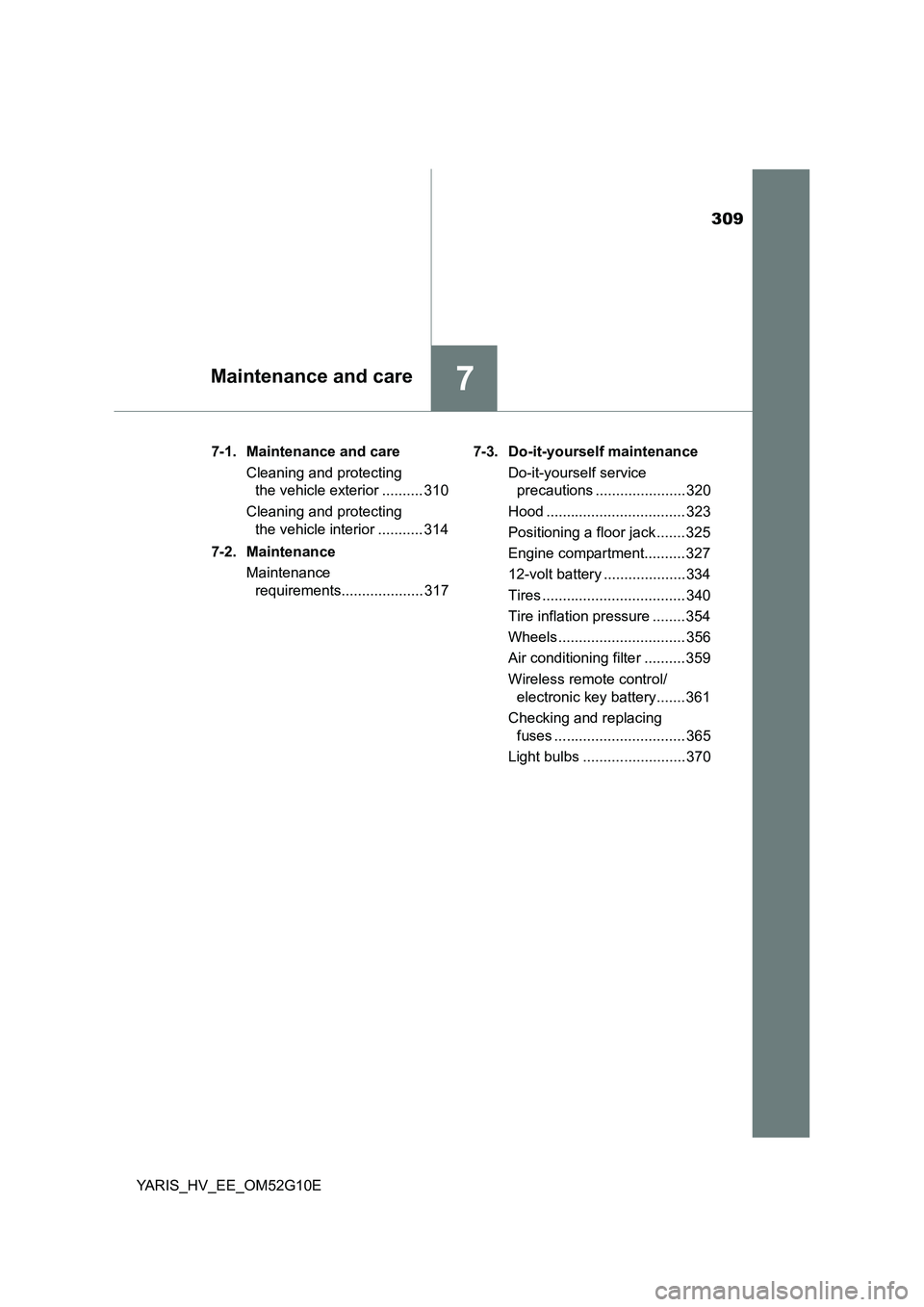
309
7Maintenance and care
YARIS_HV_EE_OM52G10E
7-1. Maintenance and care
Cleaning and protecting
the vehicle exterior .......... 310
Cleaning and protecting
the vehicle interior ........... 314
7-2. Maintenance
Maintenance
requirements.................... 317
7-3. Do-it-yourself maintenance
Do-it-yourself service
precautions ...................... 320
Hood .................................. 323
Positioning a floor jack ....... 325
Engine compartment.......... 327
12-volt battery .................... 334
Tires ................................... 340
Tire inflation pressure ........ 354
Wheels ............................... 356
Air conditioning filter .......... 359
Wireless remote control/
electronic key battery....... 361
Checking and replacing
fuses ................................ 365
Light bulbs ......................... 370
Page 320 of 492
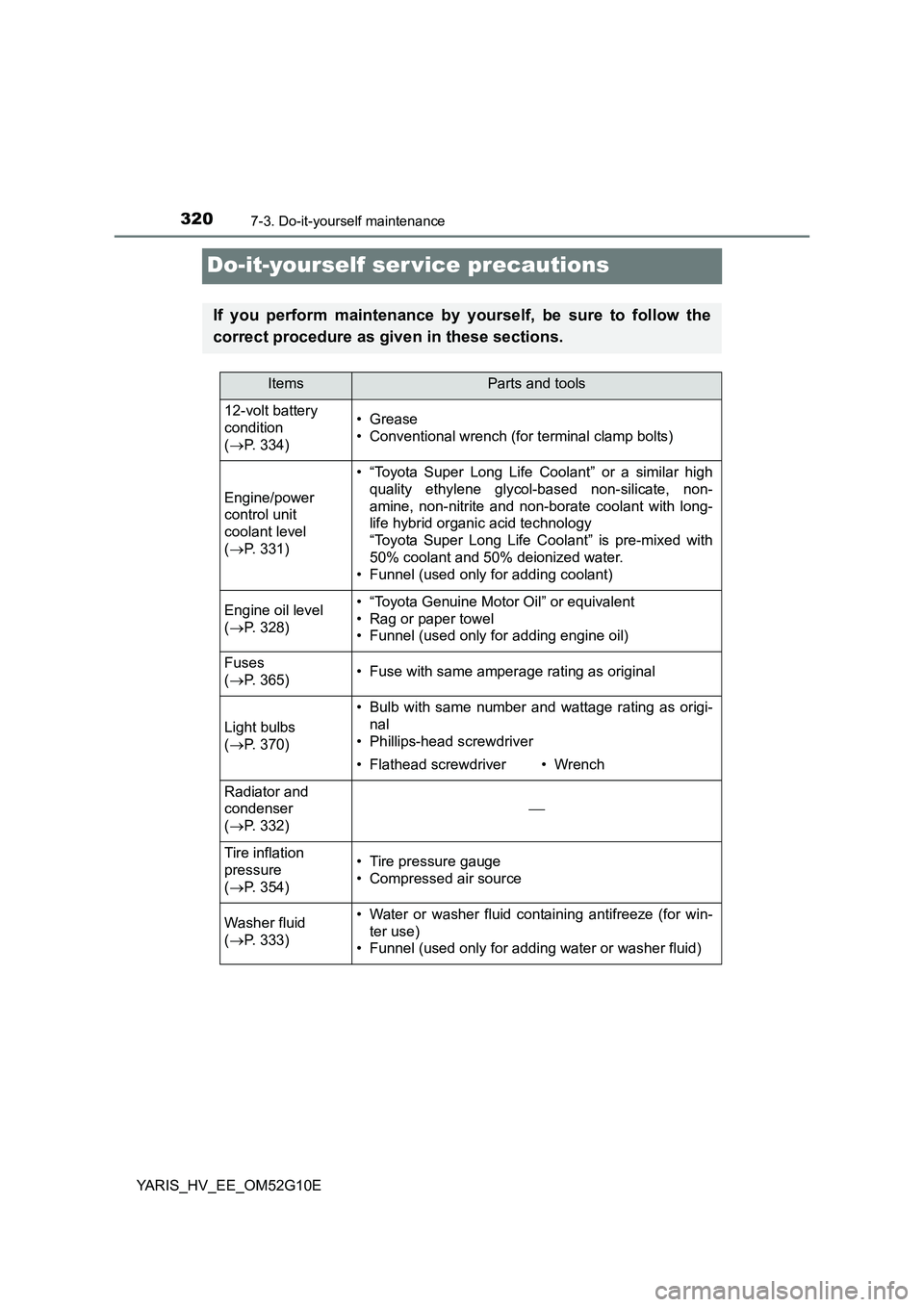
3207-3. Do-it-yourself maintenance
YARIS_HV_EE_OM52G10E
Do-it-yourself ser vice precautions
If you perform maintenance by yourself, be sure to follow the
correct procedure as given in these sections.
ItemsParts and tools
12-volt battery
condition
( P. 334)
• Grease
• Conventional wrench (for terminal clamp bolts)
Engine/power
control unit
coolant level
( P. 331)
• “Toyota Super Long Life Coolant” or a similar high
quality ethylene glycol-based non-silicate, non-
amine, non-nitrite and non-borate coolant with long-
life hybrid organic acid technology
“Toyota Super Long Life Coolant” is pre-mixed with
50% coolant and 50% deionized water.
• Funnel (used only for adding coolant)
Engine oil level
( P. 328)
• “Toyota Genuine Motor Oil” or equivalent
• Rag or paper towel
• Funnel (used only for adding engine oil)
Fuses
( P. 365)• Fuse with same amperage rating as original
Light bulbs
( P. 370)
• Bulb with same number and wattage rating as origi-
nal
• Phillips-head screwdriver
• Flathead screwdriver•Wrench
Radiator and
condenser
( P. 332)
Tire inflation
pressure
( P. 354)
• Tire pressure gauge
• Compressed air source
Washer fluid
( P. 333)
• Water or washer fluid containing antifreeze (for win-
ter use)
• Funnel (used only for adding water or washer fluid)
Page 342 of 492
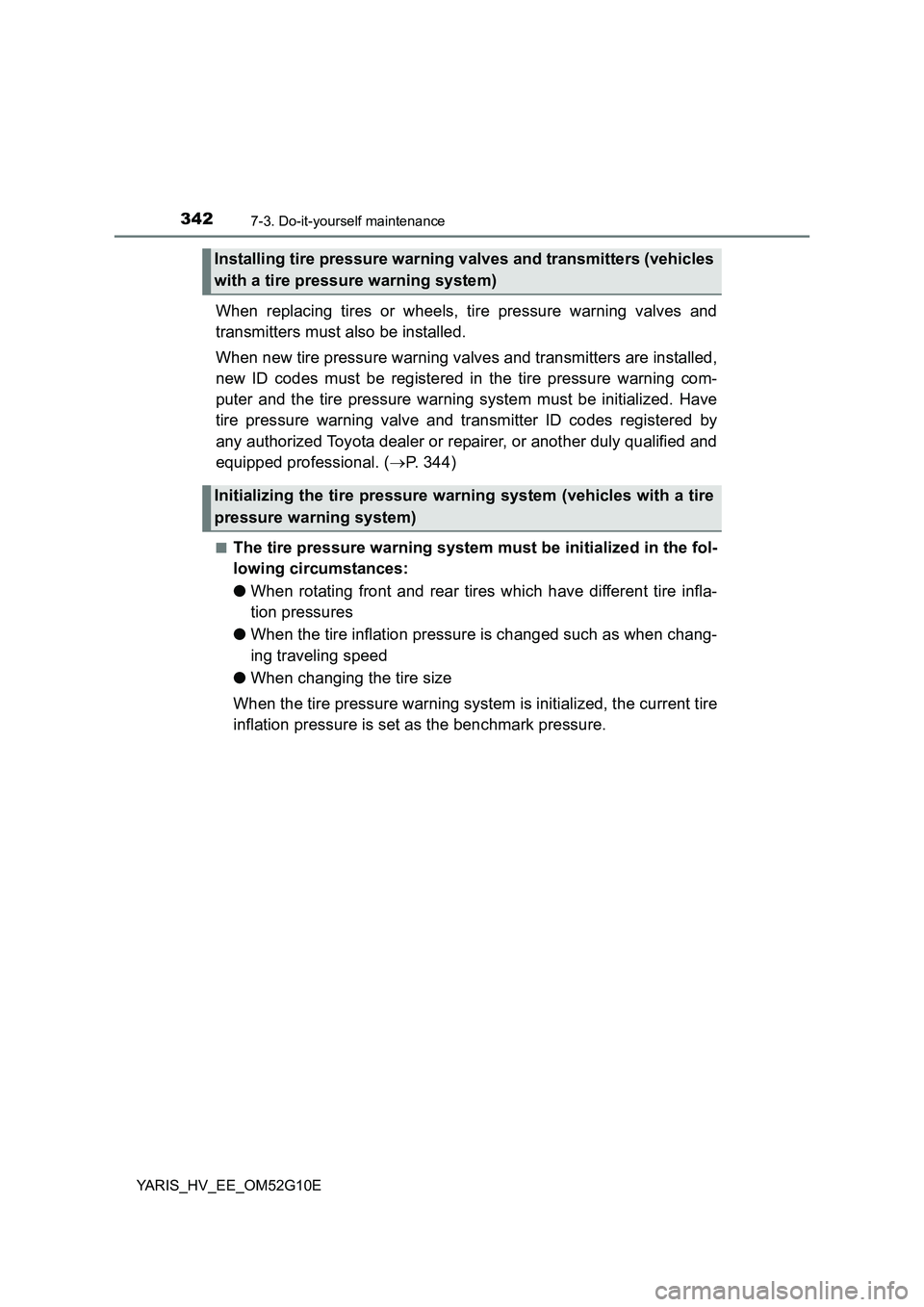
3427-3. Do-it-yourself maintenance
YARIS_HV_EE_OM52G10E
When replacing tires or wheels, tire pressure warning valves and
transmitters must also be installed.
When new tire pressure warning valves and transmitters are installed,
new ID codes must be registered in the tire pressure warning com-
puter and the tire pressure warning system must be initialized. Have
tire pressure warning valve and transmitter ID codes registered by
any authorized Toyota dealer or repairer, or another duly qualified and
equipped professional. ( P. 344)
■The tire pressure warning system must be initialized in the fol-
lowing circumstances:
● When rotating front and rear tires which have different tire infla-
tion pressures
● When the tire inflation pressure is changed such as when chang-
ing traveling speed
● When changing the tire size
When the tire pressure warning system is initialized, the current tire
inflation pressure is set as the benchmark pressure.
Installing tire pressure warning valves and transmitters (vehicles
with a tire pressure warning system)
Initializing the tire pressure warning system (vehicles with a tire
pressure warning system)
Page 343 of 492
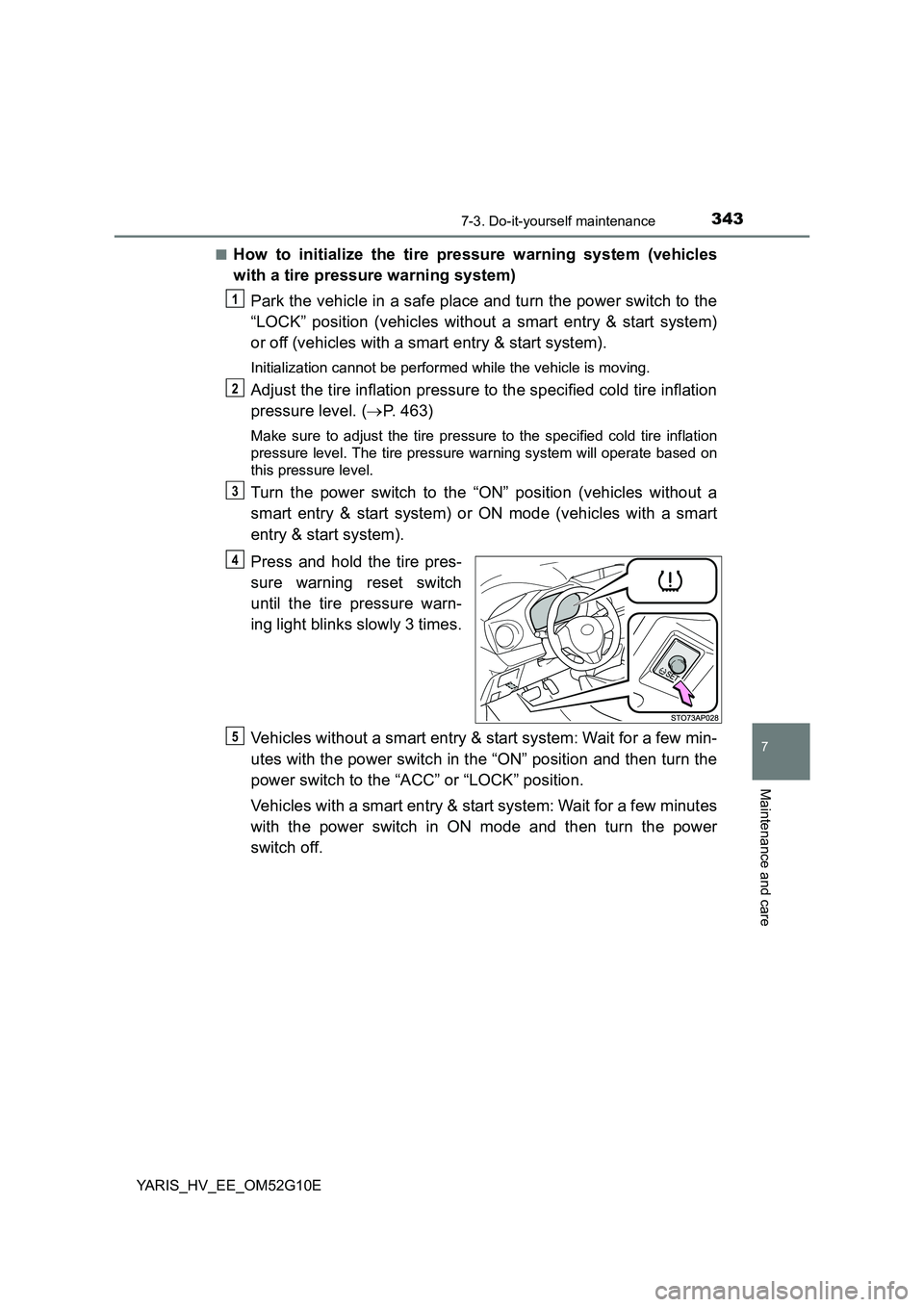
3437-3. Do-it-yourself maintenance
7
Maintenance and care
YARIS_HV_EE_OM52G10E
■How to initialize the tire pressure warning system (vehicles
with a tire pressure warning system)
Park the vehicle in a safe place and turn the power switch to the
“LOCK” position (vehicles without a smart entry & start system)
or off (vehicles with a smart entry & start system).
Initialization cannot be performed while the vehicle is moving.
Adjust the tire inflation pressure to the specified cold tire inflation
pressure level. ( P. 463)
Make sure to adjust the tire pressure to the specified cold tire inflation
pressure level. The tire pressure warning system will operate based on
this pressure level.
Turn the power switch to the “ON” position (vehicles without a
smart entry & start system) or ON mode (vehicles with a smart
entry & start system).
Press and hold the tire pres-
sure warning reset switch
until the tire pressure warn-
ing light blinks slowly 3 times.
Vehicles without a smart entry & start system: Wait for a few min-
utes with the power switch in the “ON” position and then turn the
power switch to the “ACC” or “LOCK” position.
Vehicles with a smart entry & start system: Wait for a few minutes
with the power switch in ON mode and then turn the power
switch off.
1
2
3
4
5
Page 345 of 492
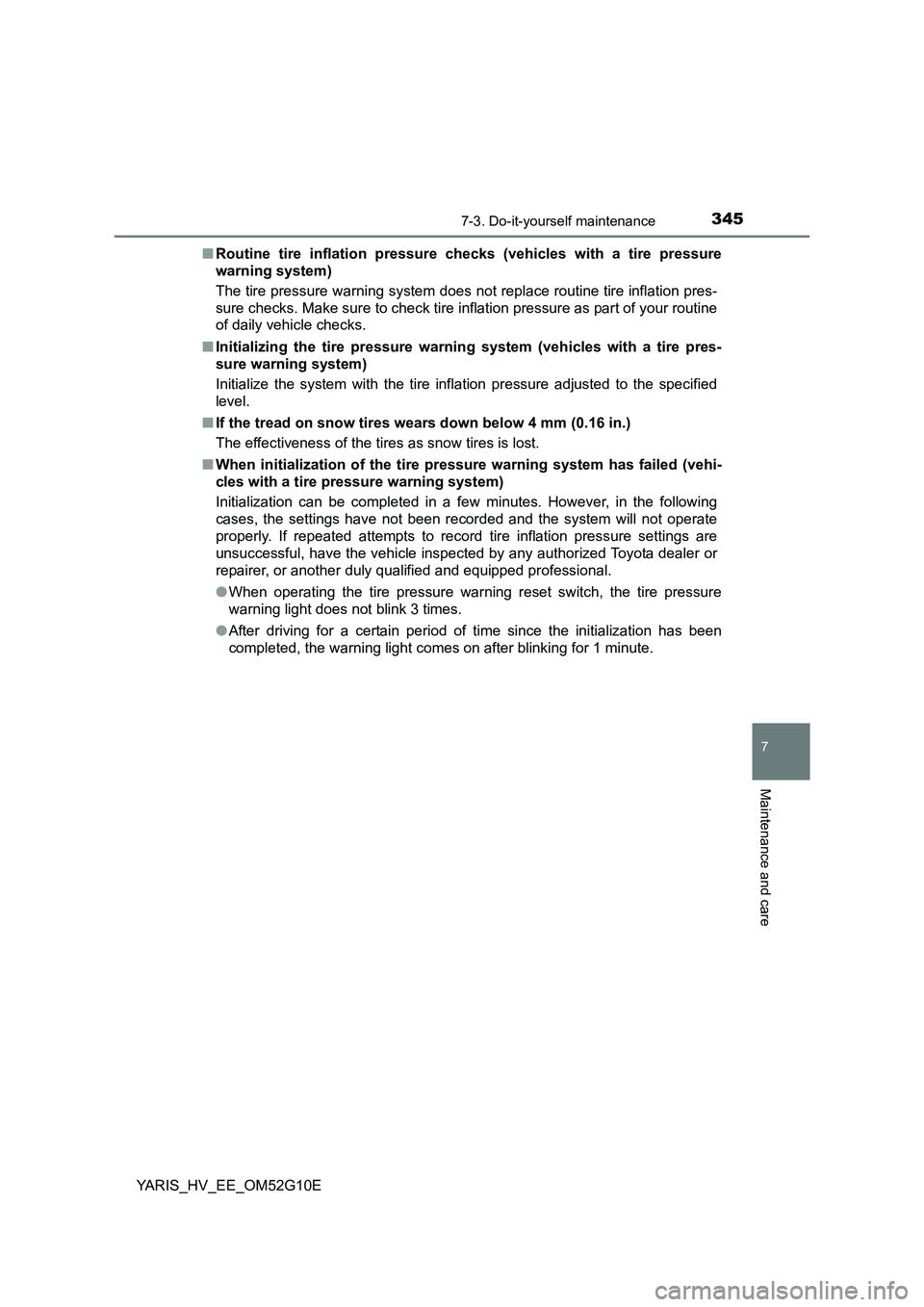
3457-3. Do-it-yourself maintenance
7
Maintenance and care
YARIS_HV_EE_OM52G10E
■ Routine tire inflation pressure checks (vehicles with a tire pressure
warning system)
The tire pressure warning system does not replace routine tire inflation pres-
sure checks. Make sure to check tire inflation pressure as part of your routine
of daily vehicle checks.
■ Initializing the tire pressure warning system (vehicles with a tire pres-
sure warning system)
Initialize the system with the tire inflation pressure adjusted to the specified
level.
■ If the tread on snow tires wears down below 4 mm (0.16 in.)
The effectiveness of the tires as snow tires is lost.
■ When initialization of the tire pressure warning system has failed (vehi-
cles with a tire pressure warning system)
Initialization can be completed in a few minutes. However, in the following
cases, the settings have not been recorded and the system will not operate
properly. If repeated attempts to record tire inflation pressure settings are
unsuccessful, have the vehicle inspected by any authorized Toyota dealer or
repairer, or another duly qualified and equipped professional.
● When operating the tire pressure warning reset switch, the tire pressure
warning light does not blink 3 times.
● After driving for a certain period of time since the initialization has been
completed, the warning light comes on after blinking for 1 minute.